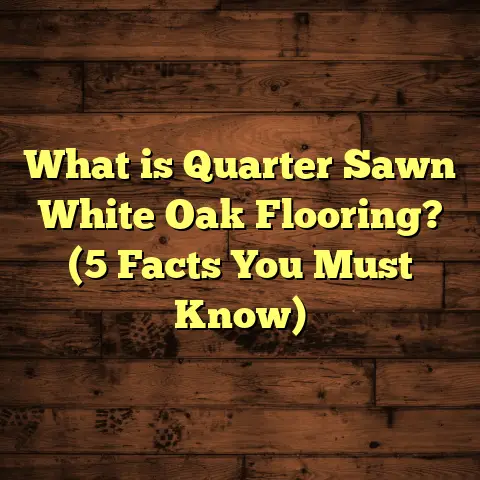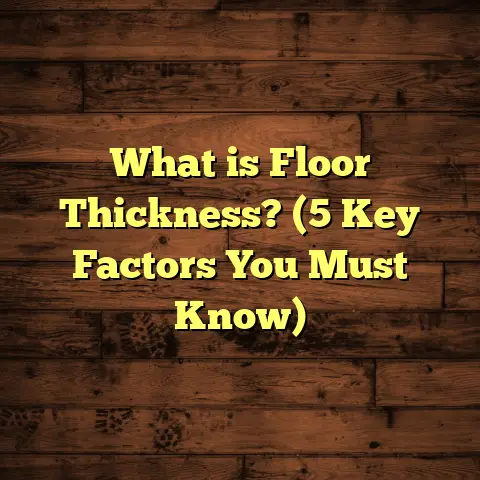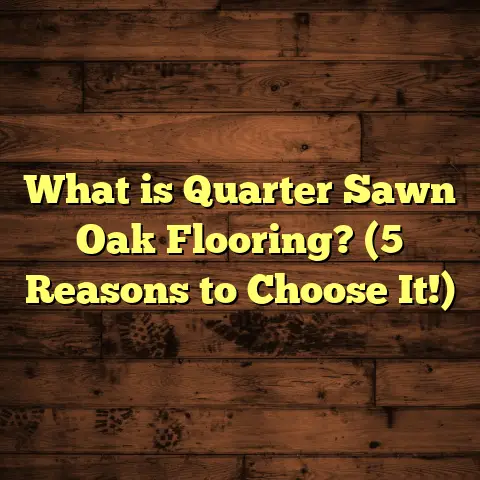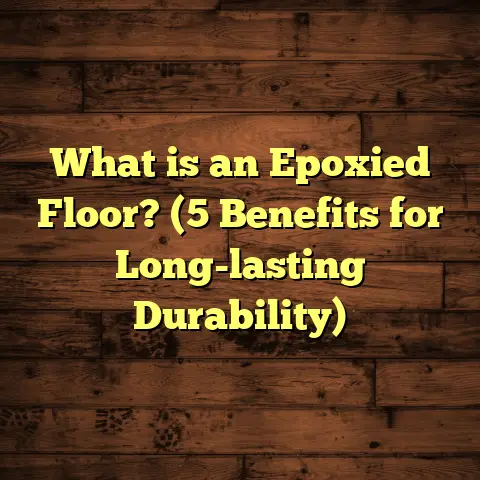What is a Wholesale Price for Red Oak Hardwood Floors? (5 Tips to Save!)
I still remember the day I finished installing a massive 2,000-square-foot red oak hardwood floor
for a client who wanted an elegant, timeless look for their home. That project taught me a lot
about pricing, sourcing, and how to get the best value for this classic flooring material.
One question I get asked often is: “What exactly is a wholesale price for red oak hardwood floors?”
It’s not just about numbers — it’s about understanding the market, the material quality, and smart buying strategies.
So, I’ll walk you through everything I’ve learned over years of hands-on flooring work, share some personal stories,
and even give you tips to save money along the way.
If you’re thinking of installing red oak hardwood floors or planning a big project,
this is the kind of info I wish someone had handed me when I started out.
What is a Wholesale Price for Red Oak Hardwood Floors?
When I talk about wholesale price, I mean the cost you pay when buying red oak hardwood flooring
directly from suppliers or manufacturers, usually in bulk quantities. This price is generally lower than retail because it cuts out the middlemen, like big box stores or flooring retailers.
Think of wholesale price as the “factory gate” price before any markup adds up.
Why is this important? If you’re planning a big flooring project or working as a contractor,
buying at wholesale rates can save you hundreds or even thousands of dollars.
Here’s a more detailed breakdown to help you understand what wholesale pricing really involves:
- Bulk Purchases: Wholesale prices are usually reserved for buyers who purchase in large quantities — typically at least 500 to 1,000 square feet or more. Smaller orders usually don’t qualify.
- Direct Relationships: To get wholesale pricing, you often need to work directly with mills, lumber yards, or authorized distributors instead of retail outlets. This means building partnerships and sometimes having a business license or proof you are a contractor.
- Lower Markups: Retailers add markups to cover their expenses like rent, staff wages, and marketing. Wholesale sellers sell at much closer to their cost or with smaller margins because they sell higher volumes.
- Material Quality Control: Wholesale buyers usually have more say in selecting specific grades or cuts of wood because they order in bulk and can specify preferences.
Breaking It Down: Why Wholesale Prices Vary
Red oak flooring prices can shift based on a few key factors:
- Grade of Wood: Clear grade wood (which has fewer knots and imperfections) costs more than select or common grades, which have more character but are cheaper.
- Finish: Prefinished planks are pricier than unfinished ones because finishing requires labor, materials, and time. Unfinished wood means you handle sanding and finishing later, which can save money upfront but adds labor costs later.
- Plank Size: Wider and longer boards typically have higher prices because they take longer to harvest and produce with fewer defects. Narrower planks are often less expensive but may create a busier floor pattern.
- Source Location: Local mills might charge less than imported wood due to lower shipping costs. However, imported wood sometimes offers unique grain patterns and finishes that justify higher prices.
- Order Volume: Larger orders usually get better per-square-foot prices because suppliers want to move big quantities at once.
From my experience over dozens of projects, buying 1,000 sq ft at once can knock off 15-25% compared to smaller loads. This percentage varies by supplier and region but is consistent enough that it’s worth planning your purchase volume carefully.
How Much Does Red Oak Hardwood Floor Cost Wholesale?
I keep tabs on market prices regularly because those numbers fluctuate with supply, demand, and lumber market conditions.
Here’s a snapshot of what those prices looked like recently when I checked with several suppliers around the Midwest and East Coast:
| Wood Grade | Finish | Price Per Sq Ft (Wholesale) |
|---|---|---|
| Select & Better | Unfinished | $2.50 – $3.00 |
| Select & Better | Prefinished | $3.50 – $4.50 |
| #1 Common | Unfinished | $1.80 – $2.20 |
| #1 Common | Prefinished | $2.50 – $3.50 |
For comparison’s sake, retail prices at big box stores typically run:
- Select & Better Prefinished: $5 – $7 per sq ft
- Common Grade Prefinished: $3 – $5 per sq ft
That difference between retail and wholesale can be quite noticeable.
On one particular job early in my career, I quoted a retail price of $6 per sq ft for red oak planks that I personally got at wholesale for under $4. That margin means a lot when you’re managing budgets or bidding on projects.
How Market Trends Affect Pricing
You might wonder why wholesale prices fluctuate so much?
Several factors influence the lumber market and thus impact red oak hardwood prices:
- Supply Chain Issues: Events like transportation strikes or port delays can cause sudden price spikes.
- Seasonal Demand: Flooring demand often rises in spring and summer when people renovate homes more frequently, pushing prices higher temporarily.
- Lumber Harvesting Cycles: Oak trees take decades to mature so supply can’t ramp up quickly when demand surges.
- Economic Conditions: Inflation or tariffs on imports can increase costs for mills and distributors.
I always recommend monitoring these trends if you’re planning a big purchase but aren’t in a rush. Sometimes waiting a couple of months can save you real money.
My Personal Experience Buying Red Oak Hardwood Floors
Back when I started flooring work myself about 10 years ago, I didn’t know much about wholesale pricing.
I’d buy from local stores at retail rates and cringe every time I saw the bill.
One day, a mentor contractor pulled me aside and said, “You need to work your supplier relationships.”
That was a turning point.
I started contacting mills directly and asking for bulk quotes. It wasn’t always easy—sometimes they required minimum orders or proof of business—but after a few tries, I got better deals.
Here’s what I learned:
- Build Relationships: Suppliers are more likely to cut you a deal if you’re a repeat buyer or if you show professionalism. A simple phone call or visit can go a long way.
- Buy Larger Quantities: Even if you don’t need all the wood immediately, buying in bulk saves money long-term because of volume discounts and lower freight costs per square foot.
- Go Unfinished If You Can: Finishing yourself or hiring a local finisher often lowers costs because prefinished wood has finishing labor baked in.
For example: On one project where budget was tight but quality mattered, I ordered unfinished red oak at wholesale rate ($2.75/sq ft), then hired a local finisher who charged $1 per sq ft to sand and finish onsite — still cheaper than prefinished wood at retail ($4+).
5 Tips to Save on Red Oak Hardwood Flooring Costs
Let me share five practical tips that helped me save money without sacrificing quality:
1. Shop Around and Compare Wholesale Quotes
Don’t settle for the first offer you get. Call multiple suppliers and mills in your area or online.
Prices can vary widely based on their stock and shipping fees.
I once found a mill offering red oak at $0.50 less per square foot than my usual supplier for the same grade—saving me nearly $500 on one project!
2. Consider Buying Unfinished Wood
Prefinished floors look great but come with extra costs baked in.
If you have access to a good finisher or want to DIY sanding and finishing, unfinished wood is cheaper wholesale.
In one of my recent projects, using unfinished red oak saved about 20% compared to prefinished options.
Plus, finishing onsite means you can customize stains and finishes to exactly what the client wants.
3. Factor in Waste but Don’t Overbuy
Wood flooring needs an extra 5-10% for cutting waste and mistakes.
But buying too much “just in case” ties up your cash unnecessarily.
I use tools like FloorTally to calculate material needs precisely — including waste factors — so I never buy too much or too little.
This has saved me from spending hundreds extra on unneeded wood that just sits in storage.
4. Time Your Purchase Strategically
Certain times of year (like late winter or early spring) sometimes have better deals when suppliers are clearing inventory.
I snagged a bulk order last February at 15% below usual pricing just because the supplier was making room for new stock.
Sometimes ordering during slower business months gives you leverage to negotiate better rates.
5. Negotiate Payment Terms
Sometimes suppliers will give better wholesale prices if you pay upfront or buy regularly from them.
Building trust with your supplier can open doors to discounts or priority shipping—both valuable perks.
Don’t hesitate to ask if there’s room for negotiation on price or terms; you might be surprised what’s possible just by asking nicely.
How FloorTally Helps Me Manage Flooring Costs
One challenge I faced early on was juggling all these numbers — materials prices, labor rates, waste factors — while trying not to lose money on estimates.
Managing every detail manually was exhausting and error-prone.
That’s where FloorTally fits perfectly into my workflow now.
This tool lets me input materials, sizes, labor costs, waste percentages — everything — and then spits out detailed estimates quickly.
Instead of juggling multiple spreadsheets or guessing quantities, I get an accurate cost picture before buying anything.
For example:
- When planning recent red oak hardwood floor installs, FloorTally helped me spot that buying unfinished wood plus finishing onsite was cheaper overall — even after factoring labor costs.
- It adjusts estimates based on my local labor rates and material prices from suppliers I regularly work with.
- It also calculates waste factors precisely so I avoid overbuying material — a huge money saver over many projects.
Using FloorTally keeps my bids realistic and clients happy because there are fewer surprises during installation.
What Affects the Quality and Price of Red Oak Hardwood Floors?
If you want good value at wholesale prices, understanding quality factors is key:
Wood Grade
Grades range from clear (almost no knots) to common (more knots and natural markings).
Clear grade is more expensive but looks cleaner and is often preferred in formal spaces.
Common grade has character but may not suit all homeowners’ aesthetics.
I always ask clients what visual style they want before deciding on grade—sometimes common grade works great in rustic or casual settings.
Cut Type
Red oak can be plain-sawn or quarter-sawn.
Quarter-sawn boards cost more but wear better over time and show beautiful ray flecks in the grain.
Plain-sawn is cheaper but less stable dimensionally—more prone to cupping or warping if installed improperly.
Finish Type
Oil-based finishes add warmth but require maintenance every few years.
Polyurethane finishes are tougher but can look plastic-y if over-applied.
Prefinished boards come sealed with factory finishes that are consistent but limit onsite customization options.
Thickness
Thicker planks (¾ inch typical) cost more but can be sanded and refinished multiple times over decades.
Thinner planks are less expensive upfront but may need replacement sooner if damaged.
Moisture Content
Properly dried wood (6-9% moisture content) avoids warping post-installation.
Cheap wood sometimes isn’t kiln-dried properly — leading to headaches after install with cupping or gaps appearing.
From experience, spending a bit more on higher-grade, properly dried red oak pays off because it lasts longer and looks better — which clients appreciate down the line.
Real-Life Case Study: Saving Money on a Big Red Oak Project
A while back, I worked on a 3,000-square-foot home where the owners wanted red oak floors everywhere except bathrooms.
They had a limited budget but wanted real hardwood floors throughout their living spaces.
Here’s what I did step-by-step:
- Ordered unfinished red oak from a mill at wholesale price ($2.80/sq ft) instead of retail ($4+).
- Coordinated with a local finishing company who charged less than prefinished flooring premiums ($1/sq ft).
- Used FloorTally to calculate exact amounts needed plus 7% waste for cuts and mistakes.
- Negotiated payment terms with supplier: half upfront and balance on delivery in exchange for faster shipping and slight discount (around 3%).
- Scheduled installation efficiently so finishers could work immediately after laying planks — minimizing labor overlap costs.
The result? They saved around $7,000 compared to retail pricing with prefinished wood — and loved the custom finish we applied onsite.
This project reaffirmed how knowing wholesale pricing and managing supplies well makes a huge difference financially without sacrificing quality or style.
Looking Beyond Price: What About Installation Costs?
Sometimes people focus solely on material prices but forget installation charges add up fast—and those can vary widely depending on job complexity.
For red oak hardwood floors:
- Installation labor usually runs between $3 to $5 per sq ft depending on room layout complexity and subfloor condition.
- Subfloor prep (removal of old flooring or leveling) adds extra fees.
- Finishing onsite (if unfinished wood) means additional labor costs but lower material expenses overall.
- Additional costs include baseboard removal/reinstallation, stair nosing installation, and trim work around doorways.
- Tools like FloorTally help me estimate these combined costs accurately before giving clients bids so there are no surprises mid-project.
Balancing material savings with installation quality is important—cheap wood with poor install ends up costing more in repairs later down the line.
How Different Regions Affect Wholesale Pricing
Where you are located also makes a difference in wholesale pricing for red oak hardwood floors:
- Midwest & Northeast: Plenty of local mills supplying eastern red oak means competitive prices here.
- South & West: Shipping costs tend to increase overall price since regional mills may be fewer.
- Urban Areas: Higher demand often drives up pricing due to competition between contractors.
- Rural Areas: Some suppliers charge extra for delivery remote locations but may offer discounts on bulk pickups.
I always recommend getting local quotes before committing because regional differences can be as much as 20% on similar products.
How Environmental Certifications Impact Cost
If you care about sustainability (and many clients do), certifications like FSC (Forest Stewardship Council) add another pricing layer:
- FSC-certified red oak comes from responsibly managed forests.
- These products often carry premium prices due to stricter harvesting regulations.
- Some buyers find paying extra worthwhile for environmental peace of mind.
I’ve worked with clients who requested FSC-certified wood specifically; it added about 10% to cost but aligned with their values perfectly.
Comparing Red Oak Hardwood Floors to Other Popular Options
To put things into perspective:
| Flooring Type | Average Wholesale Cost Per Sq Ft | Typical Installation Cost Per Sq Ft |
|---|---|---|
| Red Oak Hardwood | $2 – $4 | $3 – $5 |
| Maple Hardwood | $3 – $5 | $3 – $6 |
| Hickory Hardwood | $3 – $5 | $3 – $6 |
| Laminate Flooring | $1 – $2 | $1 – $3 |
| Vinyl Plank Flooring | $2 – $4 | $2 – $4 |
Red oak is often priced attractively compared to other hardwoods while delivering excellent durability and classic appeal — which partly explains its popularity nationwide.
Why Red Oak Remains One of My Favorite Flooring Materials
Over the years doing flooring work across hundreds of homes, red oak stands out because:
- Its warm tones complement almost any décor style.
- It sands and refinish beautifully multiple times over decades.
- It’s widely available from many mills which helps keep pricing competitive.
- It’s tough enough for high traffic areas without looking worn quickly.
- It accepts stains well so homeowners can customize color easily.
I’ve seen clients fall in love with their red oak floors years after installation every time—something special about that grain pattern that never gets old!
Final Thoughts on Wholesale Pricing for Red Oak Hardwood Floors
If you’re looking to buy red oak hardwood flooring, understanding wholesale pricing gives you control over your project budget like nothing else can.
Here’s what I hope sticks with you after this read:
- Wholesale prices depend on grade, finish, size, source location, and order volume.
- Building relationships with suppliers helps unlock better deals over time.
- Tools like FloorTally simplify budgeting and reduce costly mistakes by accurate calculations.
- Being strategic about buying unfinished wood and timing purchases saves significant money.
- Always balance material cost savings with installation quality for long-term satisfaction.
- Regional differences affect pricing—get local quotes before committing.
- Sustainability certifications add cost but may align with values worth paying for.
If you keep these insights in mind as you plan your flooring project, you’ll get beautiful red oak floors without breaking your budget—and probably feel confident making decisions along the way too!
Got questions about your own project? Just ask—I’m happy to help!





